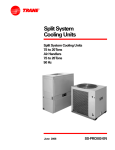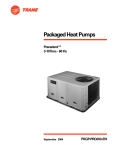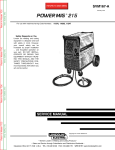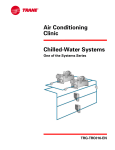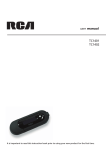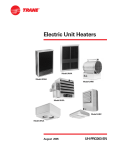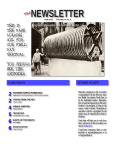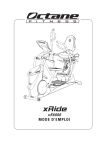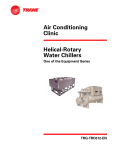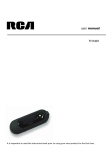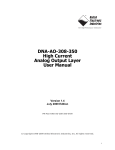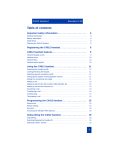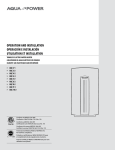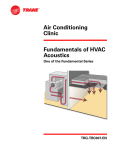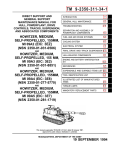Download Trane TRG-TRC014-EN User's Manual
Transcript
Air Conditioning Clinic VAV Systems One of the Systems Series TRG-TRC014-EN VAV Systems One of the Systems Series A publication of The Trane Company Preface VAV Systems A Trane Air Conditioning Clinic Figure 1 The Trane Company believes that it is incumbent on manufacturers to serve the industry by regularly disseminating information gathered through laboratory research, testing programs, and field experience. The Trane Air Conditioning Clinic series is one means of knowledge sharing. It is intended to acquaint a nontechnical audience with various fundamental aspects of heating, ventilating, and air conditioning. We have taken special care to make the clinic as uncommercial and straightforward as possible. Illustrations of Trane products only appear in cases where they help convey the message contained in the accompanying text. This particular clinic introduces the concept of variable air volume or “VAV” systems. ii © 2001 American Standard Inc. All rights reserved TRG-TRC014-EN Contents period one What Is Variable Air Volume? .......................... 1 Why VAV? ............................................................... 7 period two Components of a VAV System ...................... 12 period three System Configurations ..................................... 40 Perimeter Spaces .................................................. 41 Interior Spaces ...................................................... 46 Changeover/Bypass VAV System ........................... 47 System-Level Control Modes ................................ 48 period four Fan Modulation ................................................... 52 Fan Performance Curve ....................................... 52 System Resistance Curve .................................... 53 Fan Modulation Curve ......................................... 56 Fan Modulation Methods .................................... 58 System Static-Pressure Control .......................... 64 period five Application Considerations ............................. 68 period six Review ................................................................... 76 Quiz ......................................................................... 81 Answers ................................................................ 84 Glossary ................................................................ 85 TRG-TRC014-EN iii iv TRG-TRC014-EN period one What Is Variable Air Volume? notes VAV Systems period one What Is Variable Air Volume? Figure 2 A variable-air-volume (VAV) air-conditioning system varies the volume of constant-temperature air that is supplied to meet the changing load conditions of the space. Constant-Volume, Variable-Temperature System supply fan SA cooling coil OA RA thermostat space Figure 3 For the purpose of comparison, we will look at a traditional constant-volume (CV), variable-air-temperature system. This system delivers a constant volume of air to the space and, to maintain the required space temperature at all load conditions, varies the temperature of this air. In this example, the temperature of the air is varied by controlling the capacity of the central cooling coil. TRG-TRC014-EN 1 period one What Is Variable Air Volume? notes Constant Volume–Full Load Supply Airflow = Sensible Heat Gain Constant × (Space DB – Supply DB) 40,000 Btu/hr Supply = = 1,840 cfm Airflow 1.085 × (75°F – 55°F) 11,724 W Supply = = 0.87 m3/s Airflow 1,210 × (23.9°C – 12.8°C) Figure 4 This equation describes the performance of a constant-volume, variabletemperature system at various load conditions. Sensible Heat Gain Supply Airflow (cfm) = -----------------------------------------------------------------------------------------------------Constant × (Space DB – Supply DB) With these design conditions: space sensible heat gain = 40,000 Btu/hr [11,724 W] space dry-bulb (DB) temperature = 75°F [23.9°C] supply air dry-bulb (DB) temperature = 55°F [12.8°C] constant = 1.085 [1,210] the system balances the load with 1,840 cfm [0.87 m3/s] of 55°F [12.8°C] supply air. 40,000 Btu/hr Supply Airflow = ---------------------------------------------------------- = 1,840 cfm 1.085 × ( 75°F – 55°F ) 11,724 W Supply Airflow = ---------------------------------------------------------------- = 0.87m 3/S 1,210 × 23.9°C – 12.8°C 2 TRG-TRC014-EN period one What Is Variable Air Volume? notes Constant Volume–Part Load Supply DB – = Space DB Sensible Heat Gain Constant × Supply Airflow 20,000 Btu/hr Supply = 65°F = 75°F – DB 1.085 × 1,840 cfm 5,862 W Supply 23.9°C – = 18.3°C DB = 1,210 × 0.87 m3/s Figure 5 Rearranging the equation and using the constant supply airflow of 1,840 cfm [0.87 m3/s], the supply air temperature required to balance a lesser 20,000 Btu/hr [5,862 W] space sensible load is: Sensible Heat Gain Supply DB = Space DB – --------------------------------------------------------------------------Constant × Supply Airflow 20,000 Btu/hr Supply DB = 75°F – ------------------------------------------------ = 65°F 1.085 × 1,840 cfm 5,862W Supply DB = 23.9°C – ------------------------------------------------1,210 × 0.87m3 /S Therefore, as the space sensible load drops from 40,000 Btu/hr to 20,000 Btu/hr [11,724 W to 5,862 W], this system modulates the temperature of the constant 1,840 cfm [0.87 m3/s] supply air from 55°F to 65°F [12.8°C to 18.3°C]. Removing less energy from the air takes less energy from the central system. Therefore, with this particular system, refrigeration energy savings are realized at part load conditions, although control of space humidity levels suffers due to the warmer supply air condition. TRG-TRC014-EN 3 period one What Is Variable Air Volume? notes Constant Volume–Multiple Spaces single thermostat I’m fine. It’s stuffy in here! I’m hot! I’m freezing! Figure 6 However, because this type of system can respond to the demands of only one thermostat, it can serve only those building spaces with similar cooling requirements. If a building has many spaces with diverse cooling needs, each must be served by its own system. Constant Volume–Multiple Spaces 80°F [26.7°C] 65°F [18.3°C] 55°F air mixing [12.8°C] 65°F 55°F [18.3°C] [12.8°C] reheat coil Figure 7 Other constant-volume system designs can serve the cooling requirements of more than one space with a central fan and cooling coil. However, to do so, the cool primary air must be either reheated or mixed with warm air to produce the supply temperatures needed to balance the various space cooling loads. 4 TRG-TRC014-EN period one What Is Variable Air Volume? notes Terminal Reheat System EA OA RA supply fan PA reheat coil cooling coil thermostat SA Figure 8 The terminal reheat system uses a central air handler and cooling coil to deliver cool primary air to all the spaces. Each space has its own heating coil to temper the air to satisfy the space load. Of course, any heat added to meet the part-load requirements of a space becomes a cooling load that the refrigeration system must overcome. This can result in a nearly constant refrigeration load, even when the building is at part-load conditions. Therefore, reheating cooled air to achieve part-load supply air temperature control is not very energy efficient and is used only in special constant-volume applications, or when there is a “free” source of heat (i.e., heat recovery). Primary air (PA) is the air delivered by a central supply fan to a terminal unit. Supply air (SA) is the air delivered to a space. TRG-TRC014-EN 5 period one What Is Variable Air Volume? notes Variable-Air-Volume (VAV) System EA OA RA supply fan PA VAV cooling box coil variablevariablespeed drive thermostat SA Figure 9 In contrast, a variable-air-volume (VAV) system delivers the primary air at a constant temperature and varies the airflow to maintain the required space temperature at all load conditions. VAV–Full Load 40,000 Btu/hr Supply = = 1,840 cfm Airflow 1.085 × (75°F – 55°F) 11,724 W Supply = = 0.87 m3/s Airflow 1,210 × (23.9°C – 12.8°C) Figure 10 Similar to the constant-volume system, at design conditions the VAV system will balance the same 40,000 Btu/hr [11,724 W] space sensible load with the same 1,840 cfm [0.87 m3/s] of 55°F [12.8°C] supply air. 6 TRG-TRC014-EN period one What Is Variable Air Volume? notes VAV–Part Load 20,000 Btu/hr Supply = = Airflow 1.085 × (75°F – 55°F) 920 cfm 5,862 W Supply = = 0.43 m3/s Airflow 1,210 × (23.9°C – 12.8°C) © American Standard Inc. 2001 Air Conditioning Clinic TRG-TRC014-EN Figure 11 However, at part load, the VAV system produces a balance by modulating the volume of constant 55°F [12.8°C] supply air. In this example, the air volume required to balance the lesser 20,000 Btu/hr [5,862 W] space sensible load is: 20,000 Btu/hr Supply Airflow = ---------------------------------------------------------- = 920 cfm 1.085 × ( 75°F – 55°F ) 5,862 W Supply Airflow = ---------------------------------------------------------------- = 0.43m 3⁄ S 1,210 × 23.9°C – 12.8°C That is, 920 cfm [0.43 m3/s] of 55°F [12.8°C] supply air. Why VAV? Energy Savings ▲ Reduced fan energy ▲ Reduced refrigeration energy Figure 12 Why VAV? One reason to use a VAV system is the potential for part-load energy savings. The part-load energy savings inherent with the VAV system are twofold. First, TRG-TRC014-EN 7 period one What Is Variable Air Volume? notes the air volume reduction creates an opportunity to reduce the fan energy required to move this air. The amount of energy saved depends on the method used to modulate the capacity of the fan (to be discussed in Period Four). Second, the reduced airflow across the cooling coil causes the refrigeration system to throttle back in order to stabilize the primary air temperature. In turn, this results in a reduction in refrigeration energy compared to full load. Why VAV? Comfort ▲ Dedicated terminal units ▲ Dedicated thermostats I’m quite cozy. It’s nice in here! I’m fine. Ahhh! Figure 13 Another reason for VAV is to cost-effectively provide improved comfort. A VAV system is capable of controlling space temperature in many spaces with dissimilar cooling and heating requirements, while using only one central air handling unit (AHU). This is accomplished by providing one VAV terminal unit and thermostat for each independently controlled space. When the sun is beating against the west side of the building in the late afternoon, a VAV system can provide an increased amount of cool supply air to keep the spaces on the west exposure comfortable, while throttling back the airflow to the spaces on the east exposure so as not to overcool them. 8 TRG-TRC014-EN period one What Is Variable Air Volume? notes System Comparison constantconstant-volume, single zone constantconstant-volume, terminal reheat VAV ◆ Constant fan energy ◆ Constant fan energy ◆ Fan energy savings ◆ Refrigeration energy savings ◆ Nearly constant refrigeration energy ◆ Refrigeration energy savings ◆ Delivers comfort to only one thermal zone ◆ Delivers comfort to many spaces inefficiently ◆ Delivers comfort to many spaces efficiently ◆ Reheat energy increases at part load Figure 14 Contrasting the three systems discussed in this example, the simple, constantvolume, variable-temperature system consumes constant fan energy while providing refrigeration energy savings at part load. However, it can only deliver comfort to spaces with similar loads. The terminal reheat system can serve many spaces with dissimilar load requirements, but consumes constant fan energy and nearly constant refrigeration energy at part load. It also uses an increasing amount of reheat energy at part load. On the other hand, the variable-air-volume system is capable of providing both fan and refrigeration energy savings at part load, making it the most energy efficient of these three systems. In addition, the VAV system can efficiently serve many spaces with dissimilar cooling and heating load requirements. TRG-TRC014-EN 9 period one What Is Variable Air Volume? notes VAV Building Characteristics ▲ Variable thermal load profiles ▲ Multiple, independently-controlled spaces ▲ Common return air path Figure 15 There are some basic building characteristics that favor the application of VAV systems. We will discuss three: n Variable thermal load profiles in the spaces. n The need for multiple, independently-controlled spaces. n The existence of a common return air path. Variable Thermal Load Profiles percent space load 100 easteast-facing space westwest-facing space 75 50 25 0 6 a.m. 12 noon 6 p.m. Figure 16 A key feature of a VAV system is its ability to realize both fan and refrigeration energy savings at part-load conditions. A building with construction and utilization characteristics that cause the thermal load profiles of the spaces to vary throughout the day and year is an excellent application for a VAV system. The fact that the west-facing space in this example has a very different load profile than the east-facing space allows the VAV system to take advantage of this energy savings at all hours of the day. 10 TRG-TRC014-EN period one What Is Variable Air Volume? notes Independent Space Control ▲ Dedicated terminal units ▲ Dedicated thermostats Figure 17 Another feature of the VAV system is the ability to efficiently satisfy the comfort requirements of many different spaces within the building. As we saw from the comparison of the VAV and terminal reheat systems, the VAV system is the most efficient at performing this task. Common Return Air Path Space 1 Space 2 Space 3 Figure 18 Because the VAV system uses one central cooling coil and fan to serve many spaces, the need for a common path to allow the air to return from these spaces is significant. A return air plenum is commonly used. If return ductwork is required to connect each conditioned space to the central air handling unit, the system becomes more difficult to balance and control. TRG-TRC014-EN 11 period two Components of a VAV System notes VAV Systems period two Components of a VAV System Figure 19 Next, we will examine the individual components that compose a VAV system. Components of a VAV System return air path relief fan supply ductwork supply fan central air handler VAV box thermostat Figure 20 A simple VAV system includes the following: n Central air handler with a variable-volume supply fan, a cooling coil, possibly a heating coil, controls, filters, a mixing box, and a return or relief fan n Supply duct n VAV terminal unit, or “box,” with a thermostat and supply diffusers for each independently controlled space n Thermostat and unit controller for each terminal unit n Return plenum or duct The VAV terminal units modulate the airflow supplied to each space. 12 TRG-TRC014-EN period two Components of a VAV System notes VAV Terminal Units primary air ▲ Heating coil ▲ Filter ▲ Mixing fan airflow modulation device controller supply air Figure 21 VAV Terminal Units A VAV terminal unit is a sheet-metal assembly installed upstream of its respective space diffusers. The unit consists of an air-modulation device, control hardware and, depending on the system application, possibly a heating coil, a filter, and a small terminal mixing fan. Modulating the airflow to each individual space is accomplished using a temperature-controlled mechanical device that varies the airflow resistance in the supply duct to that space. The rotating blade damper changes airflow resistance by rotating the damper into the air stream, restricting the size of the air passage to the space. It is very cost-effective and flexible. Typically, either a pneumatic or electric controller can be used to adjust the damper. An understanding of the common VAV terminal unit types is important to understanding VAV systems. TRG-TRC014-EN 13 period two Components of a VAV System notes Single Duct, Cooling Only primary air supply air Figure 22 The simplest of all VAV terminal units is the single-duct, cooling-only terminal unit. It consists of an airflow modulation device with controls packaged in a sheet-metal enclosure. The unit can only modulate the primary airflow to the space. The primary air is supplied by a single, central air handler. This VAV terminal unit is typically used for those zones that require year-round cooling, like the interior zones of a building. It is the most common and basic type of single-duct VAV terminal unit. Single Duct, Cooling Only 100% remote source of heat tempering % airflow to space heating 0% design heating load primary air space load maximum primary airflow minimum primary airflow design cooling load Figure 23 This graph indicates how the air supplied to the space by the terminal unit varies as the space loads change. The vertical axis indicates the total airflow supplied to the space. The horizontal axis indicates the space load. The supply airflow to the space is reduced as the cooling load in the space decreases. Responding to the space thermostat, the primary airflow is modulated between maximum and minimum settings. The maximum setting is 14 TRG-TRC014-EN period two Components of a VAV System notes determined by the design cooling load of the space and the minimum setting is normally determined by the space ventilation requirement or minimum airflow for proper diffuser selection. Most cooling-only units are applied to spaces that have no need for heat. These units would operate in the region on the right-hand portion of this chart, modulating between design and minimum primary airflow. When cooling-only units are applied to spaces that do have heating requirements, the heat is provided by a remote source such as finned radiation along the wall. In these spaces, when the cooling load drops below the minimum airflow setting for the unit, overcooling the space, the remote heat source activates. When space heating is required, the remote heat source satisfies the space heating load. Most terminal unit controllers provide an output signal to control this remote source of heat. Space Heating with a VAV System terminal mixing fan heating coil plenum air remote heat source Figure 24 In addition to controlling this remote source of heat (perimeter baseboard radiation, in this example), single-duct VAV terminal units can directly provide heat to a space. This can be accomplished by adding a heating coil to each cooling-only unit or by mixing the primary air with warm plenum air before it is delivered to the space. TRG-TRC014-EN 15 period two Components of a VAV System notes VAV Reheat primary air terminal heating coil supply air Figure 25 VAV reheat terminal units provide supply-air tempering or space heating by reheating the cool primary air. This is accomplished by adding an electric, or hot-water, heating coil to the discharge of a cooling-only unit. The VAV reheat terminal unit is typically used for those zones that require seasonal cooling and heating, such as exterior zones of a building. VAV Reheat % airflow to space 100% 0% design heating load maximum primary airflow heating coil active tempering heating minimum heating airflow primary air space load minimum cooling airflow design cooling load Figure 26 In the cooling mode, the unit is controlled in the same manner as the coolingonly unit. The supply airflow is reduced as the cooling load in the space decreases. When the space cooling load drops below the minimum primary airflow setting for the unit, overcooling the space, the heating coil warms (tempers) the primary air to balance the low space cooling load. When space heating is required, the heating coil further warms the primary air to satisfy the space heating load. 16 TRG-TRC014-EN period two Components of a VAV System notes During the heating mode, the primary airflow must often be greater than the minimum setting of the unit for the cooling mode. When warm, buoyant air is supplied from the ceiling, a certain velocity is required to effectively deliver it down to the occupied portion of the space. Increased airflow may also be needed to meet the minimum requirement for proper operation of the heating coil. VAV reheat is more efficient than the constant-volume reheat system discussed earlier because heat is provided at reduced airflow and only when required. Fan-Powered Terminal Units warm plenum air parallel cool primary air series Figure 27 Another method that a single-duct VAV terminal unit can employ to heat a space is to mix warm plenum air with cool primary air. Because this method uses a small fan to draw warm air from the plenum and mix it with the primary air, they are called fan-powered terminal units. They come in two configurations, parallel and series. TRG-TRC014-EN 17 period two Components of a VAV System notes Parallel, Fan-Powered plenum air terminal mixing fan primary air supply air Figure 28 A parallel, fan-powered terminal unit consists of a primary airflow modulation device and a small, integral, constant-volume fan packaged to provide parallel airflow paths. Parallel, Fan-Powered maximum primary airflow 100% % airflow to space heating tempering plenum air 0% design heating load primary air space load minimum primary airflow design cooling load Figure 29 In the cooling mode, the unit is controlled in the same manner as the coolingonly unit. Primary airflow is reduced as the cooling load in the space decreases. When the space cooling load drops below the minimum primary airflow setting for the unit, overcooling the space, the small fan activates to mix warm plenum air with the cool primary air. This increases the total airflow to the space and creates a warmer supply air condition. If additional heating is required, with the terminal fan on, a heating coil can be used to further warm the supply air. Operating the fan is a form of energy recovery. It tempers the supply air with heat from the building and lights carried by the return air, rather than with “new” energy, thus delaying the start of the heating coil. 18 TRG-TRC014-EN period two Components of a VAV System notes When in cooling mode, the supply airflow to the space equals the primary airflow. When in tempering and heating modes, the space receives a constant supply airflow equal to the minimum primary airflow plus the plenum airflow delivered by the terminal fan. Usually the primary airflow is not allowed to shut off completely because of the space requirement for ventilation air. Series, Fan-Powered primary air terminal mixing fan plenum air supply air Figure 30 A series, fan-powered terminal unit consists of an airflow modulation device and a small, constant-volume fan, packaged so that their airflow paths are in series. The terminal unit fan operates continuously whenever the space is occupied. The fan draws air from either the primary air stream or the plenum, based on the thermostat in the space. This results in a constant volume of supply air delivered to the space at all times. TRG-TRC014-EN 19 period two Components of a VAV System notes Series, Fan-Powered maximum primary airflow % airflow to space 100% tempering heating plenum air 0% design heating load primary air space load minimum primary airflow design cooling load Figure 31 In the cooling mode, the primary airflow is reduced as the cooling load in the space decreases. The total supply airflow to the space remains constant, a combination of cool primary air and warm plenum air. If the space cooling load drops below the minimum primary airflow setting for the unit, or if space heating is required, a heating coil can be used to further warm the supply air to the space. The maximum airflow for the airflow modulation device typically equals the terminal fan airflow. This means that at the design cooling load, primary airflow equals supply airflow. Parallel Versus Series Fan-Powered ▲ Constant airflow to the space ▲ Acoustics ▲ Fan energy consumption Figure 32 Series, fan-powered units are generally considered the premium VAV system because while the central system operates as a variable-volume system, the spaces receive constant supply airflow. Increased air motion in the space improves comfort at all load conditions and the constant airflow simplifies diffuser selection. 20 TRG-TRC014-EN period two Components of a VAV System notes Most designers also believe that series units offer improved acoustical conditions in the space. The constant sound of the series unit, with the fan operating whenever the space is occupied, is generally preferred to the on-off sound generated by the cycling fan in the parallel unit. However, because the fan runs continuously whenever the space is occupied, a series fan-powered unit consumes more energy than a parallel fan-powered unit. The development of high-efficiency motors has lessoned the energy consumption difference. The fan in a series fan-powered unit also costs more than an equivalent parallel fan-powered unit because it generally requires a larger terminal fan. Fan-powered terminal units without a heating coil are typically used to provide tempering for those zones that require year-round cooling and have relatively high minimum airflow settings, such as the densely occupied interior zones of a building (i.e., a conference room). A fan-powered terminal unit with a heating coil is typically used for spaces that require seasonal cooling and heating, such as the exterior zones of a building. Units with heating coils are the most common of the fan-powered terminal units. Single-Duct VAV Systems central air handler OA 90°F PA 55°F [12.8°C] [32.2°C] VSD EA RA 80°F singlesingle-duct VAV terminal units [26.7°C] Figure 33 The types of terminal units discussed so far are used in single-duct VAV systems. Single-duct VAV systems use a central return-air path that allows the air from the spaces to come back to the air handler. At the air handler, a portion of this return air is recirculated and mixed with outdoor air (introduced for space ventilation purposes). This mixture of outdoor and recirculated return air, or primary air, is then conditioned and delivered to the VAV terminal units through the supply duct system. The remainder of the return air is exhausted from the building. TRG-TRC014-EN 21 period two Components of a VAV System notes Dual-Duct warm primary air cool primary air supply air Figure 34 A dual-duct terminal unit consists of two airflow modulation devices with controls packaged in a sheet-metal enclosure. One controls the cool primary air and the other controls the warm primary air. Depending on the method of control, these two air streams may mix in the dual-duct unit before proceeding downstream to the space. This VAV terminal unit is intended for zones that require seasonal cooling and heating, typically the exterior zones of a building. It is seldom used because of the high first cost incurred to provide two duct systems. A dual-duct terminal unit can be controlled to provide either a variable volume or a constant volume of supply air to the space. 22 TRG-TRC014-EN period two Components of a VAV System notes Variable Air Volume to the Space % airflow to space 100% heating tempering warm primary air cool primary air 0% design heating load space load maximum primary airflow minimum primary airflow design cooling load Figure 35 As before, this graph indicates how the air supplied to the space by the terminal unit varies as the space loads change. The vertical axis indicates the total airflow (cool primary air plus warm primary air) supplied to the space. The horizontal axis indicates the space load. To deliver a variable volume of supply air to the space in a two-fan, dual-duct system in the cooling mode, the dual-duct unit is controlled in the same manner as the cooling-only unit. The cool primary airflow is reduced as the cooling load in the space decreases. When the space cooling load drops below the minimum cool primary airflow setting for the unit, overcooling the space, the second modulating device begins to open. This allows the warm primary air to mix with the cool primary air and provide warmer supply air to the space. As the cooling load decreases further and the space requires heating, more warm primary air is mixed with the minimum amount of cool primary air. TRG-TRC014-EN 23 period two Components of a VAV System notes Constant Air Volume to the Space maximum primary airflow % airflow to space 100% warm primary air cool primary air 0% design heating load minimum primary airflow design cooling load space load Figure 36 To deliver a constant volume of supply air to the space in a two-fan, dual-duct system as the cooling load in the space decreases, the amount of cool primary air is reduced and the amount of warm primary air is increased, maintaining a constant total supply airflow to the space. Because of this constant airflow to the space, no fan energy savings is realized at part-load conditions. Single-Fan, Dual-Duct VAV System central air handler OA 40°F 55°F [12.8°C] 55°F [12.8°C] [4.4°C] heating coil VSD EA cooling coil RA 105°F [40.6°C] dualdual-duct VAV terminal units 75°F [23.9°C] Figure 37 Dual-duct VAV systems also have a central return-air path that allows air from the spaces to come back to the air handler. Dual-duct systems may, however, have either one or two central air handlers. At the single air handler, a portion of the return air is recirculated and mixed with outdoor air. This mixture of outdoor and recirculated return air is then diverted through either the cooling coil or the heating coil and delivered down 24 TRG-TRC014-EN period two Components of a VAV System notes the respective duct system to the modulation devices in the dual-duct VAV terminal units. While this single-fan configuration requires only one air handler, it is very complicated to control efficiently. In this example, the economizer is controlling the mixed air temperature to 55°F [12.8°C], thus saving the energy to operate the cooling coil. However, the heating coil must warm the air from 55°F [12.8°C] to the 105°F [40.6°C] primary air temperature. If the economizer was not activated, the mixed air temperature would be 75°F [23.9°C], requiring less heating energy, but now the cooling coil must operate. Optimizing the energy use of a single-fan, dual-duct system requires a very complicated control system and does not operate as efficiently as a two-fan, dual-duct system. Two-Fan, Dual-Duct VAV System OA 40°F [4.4°C] 55°F PA cooling air handler dualdual-duct VAV terminal units heating air handler EA 55°F [12.8°C] [12.8°C] RA PA 105°F [40.6°C] 75°F [23.9°C] Figure 38 Dual-duct systems can be very energy efficient when the mixing of cool and heated air is avoided and two supply fans are used – one for heating, the other for cooling. This arrangement eliminates the inefficient or wasteful reheating of mixed air in a single-fan, dual-duct system and allows an airside economizer to provide cool primary air whenever possible. At the cooling air handler, a portion of the return air is recirculated and mixed with outdoor air (introduced for space ventilation purposes). This mixture of outdoor and recirculated return air is then cooled and delivered as cool primary air to one of the modulation devices in the dual-duct VAV terminal units through the cooling supply duct system. Air delivered by the heating air handler contains only recirculated air, no outdoor air. This air is heated and delivered as warm primary airflow to the other modulation device in the dual-duct VAV terminal units through the heating supply duct system. The remainder of the return air is exhausted from the building. The cooling air modulation device typically has a minimum setting to accommodate the ventilation requirements of the space. TRG-TRC014-EN 25 period two Components of a VAV System notes VAV Terminal Unit Controls Figure 39 VAV Terminal Unit Controls Next we will explore the control of VAV terminal units. Before discussing the commonly-available control technologies, it is important to first understand a fundamental control concept: pressure-dependent versus pressureindependent control. Upstream Pressure Affects Airflow 0.70 in. H2O 1000 cfm [175 Pa] static pressure in supply duct 0.80 in. H2O [200 Pa] static pressure in supply duct VAV terminal unit (identical damper positions) [0.47 m3/s] 1300 cfm [0.61 m3/s] Figure 40 The modulating device in a VAV terminal unit changes the air resistance of the supply duct path to the space. As terminal units modulate, the static pressure within the duct system changes. The airflow that passes through the terminal unit depends not only on the position of the modulation device but also on the static pressure at the inlet. With the modulation device in a fixed position, a higher static pressure in the upstream duct will “push” more air through the terminal unit. Because the inlet static pressure constantly changes due to the modulation of the terminal units in the system and the resulting variation of 26 TRG-TRC014-EN period two Components of a VAV System notes duct static pressure, airflow to the space can vary even when the immediate modulation device does not change position. Pressure-Dependent Control ▲ Space sensor controls position of the modulating device ▲ Airflow to space depends on SP in upstream duct system Pressure-Independent Control ▲ Space sensor controls desired airflow ▲ Airflow to space is controlled directly, independent of SP in upstream duct system Figure 41 A pressure-dependent VAV control scheme uses the space temperature sensor to directly control the position of the modulating device. The actual airflow delivered to the space is a by-product of this position and depends on the duct system static pressure at the inlet of the terminal unit. Although the space temperature sensor will continually correct the position of the modulating device, the response can be sluggish and cause unacceptable temperature variations within the space. In contrast, a pressure-independent VAV control scheme directly controls the actual volume of primary air that flows to the space. An airflow-measuring device on the terminal unit makes this possible. The position of the modulation device is not directly controlled and is basically a by-product of regulating the airflow through the unit. Because the airflow delivered to the space is directly controlled, it is independent of inlet static pressure. Pressure-independent control increases the stability of airflow control, and allows minimum and maximum airflow settings to become actual airflows rather than physical positions of the modulation device. It is clearly the most popular form of VAV terminal unit control. TRG-TRC014-EN 27 period two Components of a VAV System notes Primary Airflow Measurement airflow airflow sensor measured pressure difference Figure 42 Accurate measurement of primary airflow is required to enable pressureindependent control. Most terminal units accomplish this with a multipoint airflow sensor mounted on the inlet. This sensor measures a pressure difference between the ports that face the airflow and the ports that face downstream. The result is a pressure difference signal that relates to the airflow rate passing through the modulation device. Terminal-Unit Control Technologies ▲ Pneumatic control ▲ Electronic control ▲ Direct digital control (DDC) Figure 43 Now that we understand pressure-dependent versus pressure-independent control, we will look at the technologies available to perform this control. Three control technologies are generally available in VAV terminal units. They are pneumatic, electronic, and direct digital control (DDC). 28 TRG-TRC014-EN period two Components of a VAV System notes Pneumatic Control ▲ Pneumatic Volume Regulator (PVR) provides pressure-independent control ▲ Pneumatic thermostat directly controls terminalunit fan and heat source ▲ Minimum and maximum airflow settings adjusted physically on PVR ▲ Compressed air operates modulation device, PVR, and space thermostat Figure 44 A pneumatically-controlled terminal unit has an airflow-modulation device operated by a pneumatic actuator consisting of an inflatable bladder and a return spring. The return spring positions the damper to a “normal” state (the position it assumes with no pressure applied in the bladder), typically fully open. If the pneumatic pressure increases in the bladder, the return spring compresses and the modulation device begins to close. If pneumatic pressure is allowed to bleed from the bladder, the force of the return spring expanding begins to open the modulation device. A pneumatic volume regulator (PVR) provides pressure-independent control of the VAV terminal unit. The PVR is connected to the airflow-measurement device and the pneumatic space thermostat. The PVR directs the actuator to position the modulation device to deliver the required airflow to the space. The pneumatic thermostat signal is used to reset this airflow set point, and it directly controls the terminal fan and heat source. Minimum and maximum airflow settings are physically adjusted on the PVR. Compressed air is required to operate the modulation device and to power the PVR and the space thermostat. TRG-TRC014-EN 29 period two Components of a VAV System notes Electronic Control ▲ Electronic pressure transducer provides pressure-independent control ▲ Electronic controller positions modulation device, controls terminal fan and heat source ▲ Minimum and maximum airflow settings adjusted physically on electronic controller ▲ Electric power supply operates modulation device and electronic controller Figure 45 An electronically-controlled terminal unit has an airflow-modulation device operated by an electronic actuator that can drive the modulation device open or closed. Electrically-actuated modulation devices typically do not have a spring to return them to a “normal” state if power is lost – they stop at the position they held when the power loss occurred. The actuator motor is operated with three wires: “common,” “drive open,” and “drive closed.” To drive the device open, the electronic controller applies 24 volts between the “common” and “drive open” wire. To drive the device closed, it applies 24 volts between the “common” and “drive closed” wire. To stop the actuator, no voltage is applied. Actuator drive time is determined by the design of the electric motors and gears, but is typically between one and six minutes. An electronic pressure transducer enables pressure-independent control of the VAV terminal unit. The pressure transducer is pneumatically connected to the airflow sensor for airflow measurement and is wired to the electronic controller along with the space temperature sensor. The electronic controller positions the modulation device to deliver the required airflow to the space, and operates the fan and heat source. Minimum and maximum airflow settings are physically adjusted on the electronic controller. A 24-volt power supply is required to power the unit actuator and controls. 30 TRG-TRC014-EN period two Components of a VAV System notes Direct Digital Control (DDC) central air handler communicating building automation system (BAS) DDC/VAV terminal units Figure 46 A digitally-controlled terminal unit has an airflow-modulation device operated with an electric actuator in the same manner as the electronic control option. The key difference between electronic control and direct digital control is that the digital controller uses a microprocessor as the intelligence behind the control of the terminal unit. This microprocessor enables digital communication between the unit controller and the central building automation system. The result is a system that can be monitored from a central point, offers control flexibility, and enables system-optimized control strategies. Buildings can be controlled more intelligently because the data (such as airflow, damper position, fan, and heat status) is available to perform complex system-control strategies and diagnostics from a central monitoring station. TRG-TRC014-EN 31 period two Components of a VAV System notes Direct Digital Control (DDC) ▲ Electronic pressure transducer provides pressure-independent control ▲ Digital controller positions modulation device, controls terminal fan and heat source ▲ Minimum and maximum airflow settings adjusted through communication link ▲ Electric power supply operates modulation device and electronic controller Figure 47 Similar to electronic control, an electronic pressure transducer enables pressure-independent control of the VAV terminal unit. The digital controller positions the modulation device and operates the fan and the heat source. Minimum and maximum airflow settings are adjusted through a communication link to the digital controller. A 24-volt power supply is required to power the unit actuator and controls. 32 TRG-TRC014-EN period two Components of a VAV System notes Diffusers flexible duct diffuser sheet metal supply duct primary air VAV terminal unit Figure 48 Diffusers Each VAV terminal unit is commonly connected to a downstream, sheet-metal duct that is then connected to the remotely-located diffusers by flexible ducts. Diffusers distribute the supply air effectively to the conditioned space. Proper air diffusion is an important comfort consideration, especially in VAV systems. Because VAV systems require the diffuser to provide proper space air mixing over a wide range of airflows, diffusers that are specifically intended for use in VAV applications should be used to prevent cold air “dumping” at low airflow rates. TRG-TRC014-EN 33 period two Components of a VAV System notes Linear Slot Diffuser linear slot diffuser supply air Coanda effect supply duct 55°F [12.8°C] air from space 5 ft [1.5 m] Figure 49 Linear slot diffusers are generally preferred for VAV air distribution. They use a principle known as the Coanda effect to distribute air to the conditioned space. The Coanda effect occurs when air is discharged at a relatively high velocity along the surface of the ceiling. This creates an area of low pressure that causes the supply air to hug the ceiling. As it travels along the ceiling, air from the space is drawn into, and mixed with, the supply air stream. When the air settles to the occupied levels of the space, it has reached an average temperature. The design of linear slot diffusers allows them to effectively distribute air over a wide range of airflows, making them the preferred diffuser for VAV systems. They also offer acoustical benefits over other types of diffusers. Proper selection and placement of linear slot diffusers generates air movement throughout the space, eliminating areas of stagnant and stratified air. For applications with special air-coverage requirements, such as the “blanketing” of an outside wall or window area, one-way discharge diffusers are commonly used. Such coverage is particularly useful for overcoming the downdraft problems that can occur when large volumes of heated air are distributed through ceiling diffusers. 34 TRG-TRC014-EN period two Components of a VAV System notes Ceiling–Diffuser Compatibility hanger wire ceiling tile cross T structural T Figure 50 Because variable-air-volume systems are installed in, and distribute air along the surfaces of, ceilings, it is essential that the diffusers be compatible with the ceiling design. The T-bar ceiling is possibly the most popular design. It is constructed of a grid of inverted T-shaped members suspended by wires from the floor or roof structure above. Cross members added to the load bearing T-bars generate a symmetrical ceiling pattern. Finally, ceiling tiles are laid in place and supported by this grid. TRG-TRC014-EN 35 period two Components of a VAV System notes Ceiling–Diffuser Compatibility cross T air slot flange ceiling tile mounting feet cross T structural T air slot Figure 51 The linear slot diffuser is placed on the structural T-bars with the mounting feet resting on the flanges. The cross member fits in a slot in the diffuser air opening, aligning the unit with the ceiling tile pattern. The weight of the linear slot diffuser is partially carried by the T-bar structure, but should also be augmented by hanger wires to ensure a vertical orientation and provide additional weight support. After the diffuser is mounted, ceiling tiles are trimmed and laid in place, completing the job. 36 TRG-TRC014-EN period two Components of a VAV System notes Supply Duct System central air handler diffuser flexible duct sheet metal supply duct VAV terminal unit Figure 52 Supply Duct System The supply duct system transports the primary air from the air handler to the VAV terminal units and then on to the space diffusers. A successful design achieves the following: n Minimizes the static pressure and associated power requirements of the supply fan n Minimizes the installed cost without sacrificing system efficiency n Supplies air to each VAV terminal unit without excessive noise n Accommodates space limitations without excessive pressure drop n Minimizes design time TRG-TRC014-EN 37 period two Components of a VAV System notes Duct Design ▲ ▲ Equal friction method ◆ Equal static pressure drop per unit length of duct ◆ Design can be performed by hand Static regain method ◆ Relatively constant static pressure throughout system ◆ Desirable for VAV system duct design ◆ Design often requires a computer program Figure 53 Designers commonly use two methods to engineer the supply duct system: n Equal friction n Static regain Equal friction duct systems are designed for an equal static-pressure drop per foot of duct. This results in a static pressure that is very high near the fan, and which steadily decreases until it is very low near the far terminal units. Equal friction duct systems can be easily designed by hand. Static regain duct systems strive to maintain a fairly consistent static pressure throughout the entire duct. Therefore, for VAV systems, the static regain method is recommended for sizing the supply ducts upstream of the terminal units. This relatively constant static pressure at the terminal unit inlet allows for improved selection and control. The design of a static regain duct system often requires the use of a computer program. 38 TRG-TRC014-EN period two Components of a VAV System notes Duct Design Recommendations ▲ Keep as simple and symmetrical as possible ▲ Locate main runs, branch runs, and terminal units above hallways or unoccupied spaces ▲ Minimize use of flexible ductwork upstream of terminal units ▲ Use duct lining or a duct silencer in first duct section to attenuate supply fan noise ▲ Place balancing dampers upstream of diffusers in all noncritical branches ▲ Reducing transitions should be several duct diameters upstream of terminal units Figure 54 Other publications contain more complete details related to duct design, but here are a few general recommendations: n Keep the duct layout as simple and symmetrical as possible n Place main duct runs and, when possible, branch runs and terminal units, above hallways and other “unoccupied” areas to ease installation and maintenance and to help attenuate the sound radiated to the occupied spaces n Limit the use of flexible ductwork upstream of the terminal unit n Apply a duct lining or duct silencer to the first section of the duct system in order to attenuate supply fan noise n Add balancing dampers upstream of diffusers in all noncritical branches n If needed, reducing transitions should be located several duct diameters upstream of terminal units TRG-TRC014-EN 39 period three System Configurations notes VAV Systems period three System Configurations Figure 55 To permit a complete understanding of the VAV system, we must look at it from a system level. In this section we will explore a few common space types and how VAV systems address the cooling and heating needs associated with them. Perimeter (P) Versus Interior (I) Figure 56 For simplicity, a typical building can be described as having two types of spaces, perimeter and interior. In many climates, perimeter spaces with walls and windows exposed to the outdoors require seasonal cooling and heating. Such spaces require cooling in the summer: it is warm outside, the sun is shining through the windows, people are occupying the space, and the lights are on. In the winter, when it is cold outside, these spaces require heating to offset the “skin” heat loss through the exterior walls and windows. Most interior spaces require year-round cooling due to the absence of skin heat losses and the fairly consistent amount of heat generated by people, lights 40 TRG-TRC014-EN period three System Configurations notes and equipment. Interior spaces on the top floor of a building often need to be treated as a perimeter space due to the heat gain/loss from the roof. Each space is typically served by an individual VAV terminal unit, allowing independent cooling and heating control. Perimeter Spaces overhead heating perimeter heating Figure 57 Perimeter Spaces Before a VAV terminal unit can be selected to serve a perimeter space, the designer must determine the heating load for that space. This will determine whether the heating load can be satisfied by supplying warm air through overhead diffusers or if the heating load must be handled by a separate perimeter heating system (e.g., baseboard wall fin). The guideline for heating a perimeter space is based on the skin heat loss per unit length of perimeter wall. TRG-TRC014-EN 41 period three System Configurations notes Baseboard Perimeter Heating heat loss > 450 Btu/hr/ft [430 W/m] coolingcooling-only VAV terminal unit baseboard heating system Figure 58 If the heat loss of the perimeter space exceeds 450 Btu/hr per linear foot [430 W per linear meter] of outside wall, an under-the-window, or baseboard, heating system is typically used. With this much heat loss, supplying a high quantity of warm air from overhead diffusers can cause downdrafts, leading to occupant discomfort. The cooling requirements of these perimeter spaces are served by a coolingonly terminal unit. The diffusers are located in the center of the room in order to evenly supply cool air to the space. During heating mode, the terminal unit provides minimum airflow to the space to meet the ventilation requirement. The perimeter heat source is separate, but can be controlled by the VAV terminal unit controller. Having only one controller for the space ensures proper sequencing of the cooling and heating systems. 42 TRG-TRC014-EN period three System Configurations notes Overhead Supply Perimeter Heating diffusers in center of space < 250 Btu/hr/ft [430 W/m] diffusers blanket perimeter wall 250250-450 Btu/hr/ft [240[240-430 W/m] Figure 59 If the heat loss of the perimeter space is less than 450 Btu/hr per linear foot [430 W per linear meter] of outside wall, downdrafts are less problematic and heated air supplied through ceiling diffusers can provide a satisfactory solution. Again, the rate of heat loss is used to determine the proper diffuser location. If the heat loss is between 250 and 450 Btu/hr per linear foot [240 and 430 W per linear meter] of outside wall, diffusers should discharge directly downward and blanket the perimeter walls with heated air. If the heat loss is less than 250 Btu/hr per linear foot [240 W per linear meter] of outside wall, diffusers can be located in the center of the room and still provide adequate blanketing to handle the heat loss. TRG-TRC014-EN 43 period three System Configurations notes VAV Reheat heat loss < 250 Btu/hr/ft [240 W/m] VAV reheat terminal unit Figure 60 When overhead heating is acceptable, VAV reheat, fan-powered, or dual-duct terminal units can be used to provide both perimeter cooling and heating. In cooling mode, the VAV reheat terminal unit modulates in response to the changing space cooling load, always maintaining a minimum airflow to serve ventilation requirements. For space loads below this minimum airflow, the unit maintains this constant minimum airflow and modulates the reheat coil capacity to satisfy the space tempering or heating requirements. Reheating previously-cooled primary air is not energy efficient. However, because the VAV system has already reduced the supply airflow, it must reheat only a limited amount of air. The VAV reheat system is far more energy efficient than a similarly-applied, constant-volume reheat system. 44 TRG-TRC014-EN period three System Configurations notes Fan-Powered VAV heat loss < 250 Btu/hr/ft [240 W/m] parallel, fanfan-powered VAV terminal unit Figure 61 Similarly, fan-powered terminal units can be used in perimeter spaces that require seasonal cooling and heating. In the heating mode, the parallel, fan-powered unit turns on a small fan as the first stage of heating. Doing so allows it to temper the supply air with the heat (of the building and lights) that is carried by the return air, rather than using “new” energy. When activated, the small fan also increases airflow to the space, improving the mixing of supply air and space air to prevent stagnation. Series, fan-powered terminal units may also be used in this manner. They offer the added advantage of supplying constant airflow to the space in both cooling and heating modes. Dual-Duct VAV heat loss < 250 Btu/hr/ft [240 W/m] warm primary air cool primary air dualdual-duct VAV terminal unit Figure 62 Finally, dual-duct VAV terminal units can also be used to heat and cool perimeter spaces. The specific operation of a dual-duct system was explained in Period Two. TRG-TRC014-EN 45 period three System Configurations notes Interior Spaces coolingcooling-only VAV terminal unit Figure 63 Interior Spaces Because an interior space is surrounded by spaces at the same temperature, it does not experience the same heat gain and loss fluctuations as a perimeter space. Therefore, an interior space typically requires some degree of cooling all year long to overcome the heat generated by people, lighting, and so forth. Most interior spaces are served by cooling-only terminal units that modulate in response to the changing space cooling load. They also have a minimum airflow setting to serve ventilation requirements. Interior Spaces, Reheat Required VAV reheat terminal unit Figure 64 Some types of interior spaces such as conference rooms require some amount of tempering to avoid overcooling the space at part loads. This is common for spaces in which the occupancy varies from full occupancy to two or three people. 46 TRG-TRC014-EN period three System Configurations notes Typically, either VAV reheat or fan-powered terminal units are used to provide the tempering needed to balance the reduced cooling load. Small Buildings Figure 65 Changeover/Bypass VAV System Many smaller buildings cannot afford commercial, or applied, equipment. Often constant-volume, light-commercial equipment, like a small packaged rooftop unit, will be used. Nevertheless, it may still be desirable to accommodate many independently controlled spaces economically. For these applications, a special VAV system called a changeover/bypass VAV system is available. Changeover/Bypass VAV System EA RA bypass damper OA supply fan PA VAV damper constantconstant-volume supply fan VAV to spaces SA Figure 66 Like a typical VAV system, a changeover/bypass VAV system contains an airflow-modulation device for each individually controlled space. This device modulates supply airflow in response to the space load. Instead of modulating the central supply fan, however, this system supplies constant primary airflow. TRG-TRC014-EN 47 period three System Configurations notes Any unneeded air is diverted to the return air stream, allowing individual comfort control of the spaces. At part-load conditions, when more of the primary air bypasses the space, the mixture of previously conditioned primary air and recirculated return air cuts energy use at the cooling and heating equipment. This explains the use of the term “bypass” in the name of this system. However, due to the fan providing a constant airflow, no fan energy savings is realized at part-load conditions. The term “changeover” refers to how this system handles the cooling and heating requirements of the building. The central air handler can provide either cooled or heated primary air to the space terminal units, and it makes this decision by periodically “polling” the spaces. Because it can only provide heating or cooling at a given time, this system is most appropriately used for smaller buildings that have a minimal number of incidences where heating is required in some spaces and cooling is simultaneously required in others. System-Level Control Modes ▲ Occupied mode ▲ Unoccupied mode ▲ Morning warm-up/cool-down mode Figure 67 System-Level Control Modes When designing a VAV system for a commercial application, three system-level control modes need to be addressed: n Occupied mode n Unoccupied mode n Morning warm-up/cool-down mode 48 TRG-TRC014-EN period three System Configurations notes Occupied Mode ▲ Main supply fan operates continuously ▲ Constant primary-air set point ▲ Main supply fan controlled to maintain the system static-pressure set point ▲ Outdoor air damper delivers proper amount of ventilation air ▲ Terminal units maintain respective “occupied” space thermostat set points Figure 68 In a typical commercial building, the occupied mode occurs during daytime operation. The building must be ventilated and the comfort cooling or heating temperature set points must be maintained in all occupied zones. The occupied mode is characterized as follows: n The main supply fan operates continuously. n The primary air temperature is controlled to a constant set point. n The supply fan is controlled to maintain the static-pressure set point of the system. n The outdoor air damper is controlled to deliver the proper amount of ventilation air. n All terminal units are controlled to maintain their respective occupied space temperature set points. TRG-TRC014-EN 49 period three System Configurations notes Unoccupied Mode ▲ Main supply fan operates only as needed to maintain thermostat set points ▲ Main supply fan controlled to maintain the system static-pressure set point ▲ Outdoor air damper is closed ▲ Terminal units maintain respective “unoccupied” space thermostat set points Figure 69 In a typical commercial facility, the unoccupied mode occurs at night. The building does not require ventilation because it is not occupied, and the temperature in the perimeter spaces must be prevented from getting too cold (perhaps 60°F [15.6°C]) or too hot (perhaps 85°F [29.4°C]). Temperature control of the interior spaces is typically ignored because proper control of the perimeter spaces normally adequately limits the interior space temperatures. The top floor of the building may require temperature limiting for all spaces. During the unoccupied mode, the following occurs: n The main supply fan cycles on whenever any perimeter space or a centrally located nighttime thermostat demands heating or cooling. If separate perimeter heat is installed and heat is demanded, it will operate and the main supply fan remains off. n The supply fan is controlled to maintain the static-pressure set point of the system. n The outdoor air damper is closed. n All terminal units with demand for central heating or cooling maintain their respective unoccupied temperature set points. All other terminal units remain off. 50 TRG-TRC014-EN period three System Configurations notes Morning Warm-up/Cool-down Mode ▲ Main supply fan operates continuously ▲ Main supply fan controlled to maintain the system static-pressure set point ▲ Outdoor air damper is closed, unless required for preoccupancy purge ▲ Terminal units are either fully open or modulated to maintain their respective “occupied” space thermostat set points Figure 70 The morning warm-up/cool-down mode typically occurs as a transition from the unoccupied mode to the occupied mode. It establishes the occupied comfort conditions for the building as rapidly as possible, because they were allowed to drift from occupied set point during the unoccupied mode, usually to save energy. In this mode, the building does not initially require ventilation because it is not occupied, but it may eventually be provided for a preoccupancy purge (diluting the contaminants that accumulated during the unoccupied mode). During the morning warm-up/cool-down mode, the system is controlled as follows: n The AHU fan operates continuously to provide primary air to the spaces for cooling or heating. If separate perimeter heat is installed and heat is demanded, the perimeter heat source operates and the AHU fan remains off. n The supply fan is controlled to maintain the static-pressure set point for the system. n The outdoor air damper is closed unless ventilation is needed for preoccupancy purge. n The terminal units may be fully open, allowing “wild” (uncontrolled) warmup or cool-down, or they may modulate to achieve the occupied temperature set points for a “controlled” warm-up or cool-down. Morning warm-up or cool-down mode is ended when the perimeter zone thermostats or a single, representative thermostat reaches its occupied set point. Then the system switches to the occupied mode. TRG-TRC014-EN 51 period four Fan Modulation notes VAV Systems period four Fan Modulation Figure 71 To accommodate the variable-volume requirements imposed by a VAV system, the system supply fan must be selected and controlled in such a manner that it is capable of modulating over the required airflow range without entering an unstable area of operation. First, certain VAV system basics should be reviewed, including: n The fan performance curve n The system resistance curve n The fan modulation curve 2.7 in. H2O [672.5 Pa] rpm 00 1,0 static pressure Fan Performance Curve airflow 24,000 cfm [11.3 m3/s] Figure 72 Fan Performance Curve The fan performance curve of a centrifugal fan is a plot of the airflow capacity at a given speed (rpm) versus the static pressure it generates. While a centrifugal fan produces both static and velocity pressures, it is traditional to 52 TRG-TRC014-EN period four Fan Modulation notes plot performance on the basis of the static pressure component only. Performance curves published for some packaged air handlers will include the effects of the dampers, filters, and coils that are in the unit. In this case, the static pressure capacity of the fan must be able to overcome the rest of the static pressure losses in the system (supply duct, terminal units, diffusers and grilles, and so forth). To deliver 24,000 cfm [11.3 m3/s] of air, this example fan, running at 1,000 rpm, generates 2.7 in. H2O [672.5 Pa] of static pressure. system resistance curve 2.7 in. H2O [672.5 Pa] rpm 00 1,0 static pressure System Resistance Curve 1.05 in. H2O [261.5 Pa] 15,000 cfm airflow 3 [7.1 m /s] 24,000 cfm [11.3 m3/s] Figure 73 System Resistance Curve The system resistance curve is a plot of the pressure drop, in terms of static pressure, that the system (including the supply ductwork, duct fittings, terminal units, diffusers and return grilles, coils, filters, dampers, and so forth) creates over a range of airflows. When the airflow in a system increases, the resistance also increases because more friction is experienced. When delivering 15,000 cfm [7.1 m3/s], this example system creates 1.05 in. H2O [261.5 Pa] of static pressure resistance. TRG-TRC014-EN 53 period four Fan Modulation notes Operating Point A 2.7 in. H2O system resistance curve [672.5 Pa] rpm 00 1,0 static pressure performance curve airflow 24,000 cfm [11.3 m3/s] Figure 74 When the system resistance curve is superimposed on the fan curve, the intersection predicts the airflow and static pressure at which the system will balance (operating point “A”). Running the fan in this example at 1,000 rpm will satisfy the design requirements of the system by overcoming 2.7 in. H2O [672.5 Pa] of static pressure resistance while moving 24,000 cfm [11.3 m3/s] of air. "Riding the Fan Curve" 3.15 in. H2O [784.6 Pa] 2.7 in. H2O B static pressure increase actual system resistance curve A [672.5 Pa] design system resistance curve rpm 00 1,0 airflow reduction 18,000 cfm [8.5 m3/s] 24,000 cfm [11.3 m3/s] Figure 75 During operation, a VAV system experiences changes in resistance as the VAV terminal units modulate. This creates a new system resistance curve. In response, a constant-speed fan “rides up” the performance curve from the design operating point (A) to a new balance point (B). This new operating point is at lower airflow (18,000 cfm [8.5 m3/s]) and a higher static pressure (3.15 in. H2O [784.6 Pa]). This method of modulating the airflow of the fan is called “riding the fan curve.” 54 TRG-TRC014-EN period four Fan Modulation notes Forward-Curved Centrifugal Fan 3.15 in. H2O input power B [784.6 Pa] A 2.7 in. H2O [672.5 Pa] rpm 00 1,0 18,000 cfm [8.5 m3/s] 24,000 cfm [11.3 m3/s] Figure 76 This “riding the fan curve” method of modulation can be used with any centrifugal fan. However, it is most energy efficient when applied to forwardcurved (FC) fans. The configuration of the input power curves of the FC fan are such that input power requirements drop as the fan operating point moves upward along the constant-speed performance curve. “Riding the fan curve” can be used successfully when the airflow modulation range for the system is small. On the other hand, if the system is required to modulate over a wide range of airflows, the increased static pressure experienced at reduced airflows may overpressurize the VAV terminals, resulting in greater-than-desired space airflow and noise problems. Additionally, if the fan enters an unstable area of operation at this high static pressure, fan vibration, called “surge”, and severe air pulsation within the duct system, may result. This may lead to objectionable noise levels and potentially a mechanical fan failure. TRG-TRC014-EN 55 period four Fan Modulation notes static pressure Fan Modulation Curve VAV system modulation curve sensor set point airflow Figure 77 Fan Modulation Curve The fan modulation curve illustrates the static pressure requirement of the VAV system over the range of airflows. This requirement consists of a fixed component and a variable component. The VAV system requires a minimum amount of static pressure to properly operate the terminal-unit modulation devices and diffusers. This static pressure is the fixed component. The second component of this static pressure curve is variable. This is the amount of static pressure required to overcome the system pressure losses due to the ducts, fittings, coils, filters, and so forth, at various airflows. These losses vary with changes to the system airflow. This curve describes the fan modulation needed to balance the static pressure that is required to offset these variable system losses (demand) with the static pressure produced by the fan (supply). 56 TRG-TRC014-EN period four Fan Modulation notes Fan Control Loop staticstatic-pressure sensor supply fan controller Figure 78 To achieve this balance, a simple control loop is used. First, the static pressure is sensed from a particular location in the system. Second, a controller compares this static pressure reading and the set point of the system. Finally, the fan capacity is controlled to deliver the required airflow, at a static pressure that maintains this set point at the location of the system sensor. static pressure VAV Fan Modulation actual system resistance curve design system resistance curve A VAV system modulation curve B sensor set point airflow Figure 79 We will use an exaggerated example to illustrate this system operation. Assume that the load on the system decreases, causing all or part of the VAV terminal units to modulate closed. This causes the system resistance curve to shift upwards. In response, the fan begins to “ride up” the constant-speed performance curve from the design operating point (A), trying to reach the balance point with this new system resistance curve. As a result, the fan delivers a lower airflow at a higher static pressure. TRG-TRC014-EN 57 period four Fan Modulation notes The system static pressure controller senses this higher pressure and sends a signal to the supply fan to reduce capacity. Modulating the fan capacity results in a new fan performance curve and the system balances at an operating point (B) along the fan modulation curve, bringing the system static pressure back down to the set point. Fan Modulation Methods ▲ Discharge dampers ▲ Inlet vanes ▲ Fan-speed control ▲ Variable-pitch blade control Figure 80 Fan Modulation Methods The four methods commonly used to modulate fan capacity are: discharge dampers, inlet vanes, fan-speed control, and variable-pitch blade control. We will examine these now. Discharge Dampers supply fan discharge dampers Figure 81 Discharge dampers match the static pressure supplied by the fan with the static pressure required by the system. They accomplish this by adding staticpressure loss to the system a little bit downstream of the fan. 58 TRG-TRC014-EN period four Fan Modulation notes static pressure Discharge Dampers actual system resistance curve design system resistance curve A discharge damper SP loss B airflow Figure 82 As the VAV terminal units modulate shut, the system resistance curve shifts upwards. The fan begins to “ride up” the constant-speed performance curve, from the design operating point (A), trying to reach the balance point with this new system resistance curve. As a result, the fan delivers a lower airflow at a higher static pressure. The system static pressure controller senses this higher pressure and sends a signal to the discharge dampers, instructing them to begin closing. This has no effect on the performance curve for the fan, but it does add a new staticpressure loss to the system. This moves the system resistance curve back down to where the system balances at an operating point along the desired fan modulation curve (B). This brings the system static pressure back down to its set point. Other methods are more energy efficient, so discharge dampers are rarely used for supply fan modulation. TRG-TRC014-EN 59 period four Fan Modulation notes Inlet Vanes inlet vanes supply fan Figure 83 Inlet vanes modulate the capacity of a fan by “pre-swirling” the air in the direction of fan wheel rotation before it enters the wheel. By changing the angle of air entry into the fan, the modulating inlet vanes lessen the ability of the fan wheel to “bite” the air. This reduces the airflow capacity which, in turn, reduces the power consumption and the ability to generate static pressure. static pressure Inlet Vanes actual system resistance curve design system resistance curve A inlet vane position (%) B 80% airflow 90% 100% Figure 84 This illustrates how inlet vanes control the fan operating point so that it tracks the desired modulation curve in response to reduced airflow and rising system static pressure. By closing the inlet vanes, the performance curve for the fan shifts downward. The airflow and resulting static pressure fall until the operating point balances along the fan modulation curve (B). 60 TRG-TRC014-EN period four Fan Modulation notes Fan-Speed Control supply fan variablevariablespeed drive Figure 85 Fan-speed control modulates fan capacity by varying the speed of rotation. This is commonly accomplished using a variable-speed drive on the fan motor. actual system resistance curve design system resistance curve A VAV system modulation curve B rpm 800 airflow rpm 00 1,0 pm 0r 90 static pressure Fan-Speed Control Figure 86 In response to reduced airflow and rising system static pressure, adjustable fan-speed control produces a system/fan interaction that is similar to that produced by inlet vane control. By reducing the fan speed, the performance curve for the fan shifts downward, and the airflow and resulting static pressure decrease until the operating point (B) balances along the fan modulation curve. TRG-TRC014-EN 61 period four Fan Modulation notes Variable-Pitch Blade Control variablevariable-pitch blades Figure 87 Finally, the capacity of vaneaxial fans can be modulated by adjusting the pitch angle of the actual fan blades. This diagram shows a set of fan blades that can swivel to modulate the capacity of the fan. This method of fan modulation is typically only found on very large systems. Most vaneaxial fans modulate their capacity by varying the speed of the fan. Variable-Pitch Blade Control actual system resistance curve design system resistance curve A static pressure stall region VAV system modulation curve B 35° 40° 45° 50° blade pitch (angle) airflow Figure 88 Note that the fan performance characteristics of this type of fan are slightly different from those of a centrifugal fan. Performance is plotted based on airflow at various blade angles versus total pressure (static pressure plus velocity pressure). The broken line defines the airflow and total pressure range that produces a stall condition for each blade angle. Operation in the stall region is characterized by separation of the air at the fan blade surface, resulting in instability. 62 TRG-TRC014-EN period four Fan Modulation notes In response to reduced airflow and rising system static pressure, the variablepitch vaneaxial fan responds similarly to a centrifugal fan with either inlet-vane or variable-speed capacity control. By changing the angle of the fan blades, the performance curve for the fan shifts downward, and the airflow and resulting pressure decrease until the operating point (B) balances along the fan modulation curve. Fan Modulation Comparisons 100 90 % design power 80 70 60 BI fan with discharge dampers AF fan with inlet vanes FC fan with 40 discharge 30 dampers FC fan with inlet vanes 50 20 variablevariable-pitch vaneaxial 10 0 fanfan-speed control 10 20 30 40 50 60 % design airflow 70 80 90 100 Figure 89 These curves describe the performance characteristics of each fan modulation method, in terms of the fan power required versus the percent of design airflow. Realize that these are generalized curves based on an arbitrary set of test conditions. On a generalized basis, the forward-curved (FC) centrifugal fan with inlet vanes, the variable-pitch vaneaxial fan, and fan speed control are similar in performance. To obtain a more accurate comparison for specific operating conditions, a lifecycle cost analysis should be performed. TRG-TRC014-EN 63 period four Fan Modulation notes Controlling System Static Pressure ▲ Fan outlet static-pressure control ▲ Supply duct static-pressure control ▲ Optimized static-pressure control Figure 90 System Static-Pressure Control Each of these fan-capacity control methods requires a signal from a controller that monitors static pressure, using a sensor located somewhere in the supplyduct system. This controller compares the sensed pressure to a set point and modulates the fan capacity to maintain a set point at that sensor location. There are three common methods for sensing and controlling system static pressure. They are: fan outlet static-pressure control, supply duct staticpressure control, and optimized static-pressure control. Fan Outlet Static-Pressure Control sensor located at fan outlet static pressure sensor VAV terminal units supply fan Figure 91 For the fan outlet static-pressure control method, the static pressure sensor is mounted near the outlet of the main supply fan. The controller is set to maintain the static pressure required at design flow. The appeal of this method is that the sensor can be factory-installed and tested, resulting in greater reliability and no field installation cost. If fire dampers are 64 TRG-TRC014-EN period four Fan Modulation notes included in the supply duct, this method ensures that the sensor is on the fan side of the damper so that the duct is protected from high pressures. Also, depending on the layout of the duct system, this method may eliminate the need for multiple duct-mounted sensors. It is not, however, as energy efficient as the other methods. Supply Duct Static-Pressure Control sensor located 2/3 down supply duct static pressure sensor VAV terminal units supply fan Figure 92 For the supply duct static-pressure control method, the static pressure sensor is located somewhere in the supply duct system. Typically the location of the sensor, and consequently the set point of the controller, is two-thirds of the distance between the supply fan outlet and the critical terminal-unit inlet. The critical terminal unit is at the end of the supply duct path that represents the largest total pressure drop. The sensor is field-installed, and the controller is set to maintain the pressure corresponding to that location in the duct system at design airflow conditions. In larger systems with many terminal units, determining the best sensor location for all load conditions can be difficult—often determined by trial and error and requiring multiple sensors. Field installation and adjustment of one or possibly several duct pressure sensors increases installation cost. Without factory testing, reliability may also suffer compared to the fan outlet method previously discussed. However, using this method typically allows for fan energy savings compared to the fan outlet method. TRG-TRC014-EN 65 period four Fan Modulation notes Optimized Static-Pressure Control sensor located at fan outlet supply fan damper positions static pressure sensor VAV terminal units communicating BAS fan speed or inlet vane position Figure 93 The optimized static-pressure control method combines the locationrelated benefits of fan outlet control with operating cost savings that exceed those of supply duct static-pressure control. A single static-pressure sensor is located at the fan outlet, and the controller dynamically adjusts the staticpressure set point based on the position of the modulating devices in the VAV terminal units. The DDC/VAV controllers know the position of their individual air-modulation devices and, because they are pressure independent, they will modulate to maintain the required airflow. The building automation system (BAS) continually polls the VAV terminal units looking for the most-open VAV damper. The controller resets the static-pressure set point so that at least one VAV terminal, the one requiring the highest inlet pressure, is nearly wide open. The result is that the supply fan generates only enough static pressure to get the required flow through this “critical” terminal unit. This method allows the sensor to be factory-installed and-tested. Because the pressure sensor is at the fan outlet, it can also serve as the duct high-pressure sensor. If the terminal units use DDC controls, the system-level communications are already in place, making this the lowest-cost, highest energy savings strategy. 66 TRG-TRC014-EN period four Fan Modulation notes Part-Load Comparison control method full load airflow fan static pressure 24,000 cfm 2.7 in. H2O [11.3 m3/s] [672.5 Pa] fan input power % fullfull-load power 22 hp 100% 13 hp 60% 12 hp 55% 9.5 hp 43% [16.4 kW] part load fan outlet supply duct 18,000 cfm [8.5 m3/s] 18,000 cfm [8.5 m3/s] optimized 18,000 cfm [8.5 m3/s] 2.1 in. H2O [523.1 Pa] 1.9 in. H2O [473.3 Pa] 1.5 in. H2O [373.6 Pa] [9.7 kW] [8.9 kW] [7.1 kW] Figure 94 A comparison of these static-pressure control methods demonstrates the energy savings potential. At this representative part-load condition, using the optimized static-pressure control method allows the supply fan to use only 43% of its full-load power versus 55% for the supply duct static-pressure control method. In addition to the supply fan energy savings, because the optimized staticpressure control method allows the system to operate as if the static pressure sensor was at each individual terminal unit, it ensures that no spaces are “starved” for air. There are also acoustical benefits at part load by operating the supply fan and VAV terminal units at the lowest possible duct static pressure. TRG-TRC014-EN 67 period five Application Considerations notes VAV Systems period five Application Considerations Figure 95 When designing a VAV system for a building, there are several considerations to address: n System-level ventilation n Freeze protection for coils n Part-load space humidity control n Building pressure control This is by no means the entire list of considerations when designing a VAV system, but is representative of some of the key issues. 68 TRG-TRC014-EN period five Application Considerations notes System-Level Ventilation RA OA PA VAV #1 primary air (PA) OA required ventilation fraction VAV #2 VAV #3 1000 cfm 1000 cfm 1000 cfm 3000 cfm + = + [0.47 m3/s] [0.47 m3/s] [0.47 m3/s] [1.41 m3/s] 200 cfm 200 cfm 300 cfm 700 cfm + = + [0.09 m3/s] [0.15 m3/s] [0.33 m3/s] [0.09 m3/s] 0.20 0.20 0.30 Figure 96 System-Level Ventilation During operation, a typical VAV system delivers a mixture of outdoor air and recirculated air to the multiple spaces it serves. The volume of supply air that enters a space is controlled by a temperature sensor in that space. In contrast, the ventilation requirement for a space typically remains constant as the supply airflow varies with thermal load. The challenge is to maintain the proper amount of ventilation air to each individual space while varying the supply air to that space in response to its load. ASHRAE Standard 62–1999, Ventilation for Acceptable Indoor Air Quality, includes a procedure that can be used to calculate the quantity of outside air required at the central air-handling unit in order to satisfy the ventilation requirements of the individual spaces. At part-load conditions, VAV systems typically require a constant quantity of ventilation air, resulting in an increased percentage of outdoor air at the air handler. Fixed-position dampers will result in underventilated VAV systems. TRG-TRC014-EN 69 period five Application Considerations notes Ventilation Reset outdoor airflow measurement and control RA central air handler with controls PA OA VAV terminal units with DDC controls communicating BAS Figure 97 With all three components, DDC controls on the VAV terminal units and air handler, a method to measure outdoor airflow at the air handler, and a communicating building automation system (BAS), a VAV system can use the multiple-spaces equation (Equation 6-1) from Standard 62 to dynamically operate the VAV system. Each VAV terminal unit continuously monitors primary airflow. The DDC controller also knows the ventilation air requirement. With this information, the controller can continuously calculate the space ventilation fraction of the space, or (the ventilation airflow required divided by the primary airflow being delivered). The BAS periodically gathers this data from all the VAV terminal units and solves Equation 6-1. This determines the amount of outdoor airflow that must be introduced at the system level, at the central air handler, to satisfy the ventilation requirements. The BAS then resets the outdoor airflow set point, and the outdoor airflow measuring device controls the damper accordingly. This method, called ventilation reset, ensures that all spaces are properly ventilated at all load conditions while minimizing wasteful overventilation. 70 TRG-TRC014-EN period five Application Considerations notes Freeze Protection for Coils RA 80°F [26.7°C] warm air OA mixed air 10°F [-12.2°C] cooling coil cold air Figure 98 Freeze Protection for Coils As mentioned, proper VAV system ventilation often leads to a high percentage of outdoor air at part-load conditions. Streams of air at vastly different temperatures are difficult to mix and may cause the mixed air stream to stratify, resulting in a risk of freezing the water inside the cooling coil. Air blending devices, mixing baffles, and high-velocity mixing dampers can provide effective mixing, but usually require more space in the air handler and more fan power. As an alternative, preheating the outdoor air before it enters the mixing box decreases this temperature difference, improves mixing and offers freeze protection for cooling coils. Measures to Prevent Coil Freeze-Up ▲ Drain coils during cold weather ▲ Keep water in motion ▲ Add glycol to the water ▲ Use face-and-bypass dampers to limit amount of cold airflow through coil ▲ Preheat the outdoor air (heating coil, heat recovery) Figure 99 Even with effective mixing, the temperature of the mixed air entering the coil may approach that of the outdoor air during cold weather. This may cause water inside the cooling coil to freeze. TRG-TRC014-EN 71 period five Application Considerations notes Coils can be protected from freezing in many ways, such as: n Draining the coils during cold weather n Keeping the water in motion n Adding glycol to the water n Using face-and-bypass dampers to limit the amount of cold airflow through the coil n Preheating the outdoor air with either a conventional heating coil or heat recovered from the exhaust air stream Part-Load Space Humidity Control partpart-load space conditions CV system = 75°F, 66% RH [23.9°C] [23.9°C] A A 55°F [12.8°C] D D C C mixed air B B 60°F [15.6°C] humidity ratio VAV system = 75°F, 58% RH 75°F [23.9°C] drydry-bulb temperature Figure 100 Part-Load Space Humidity Control VAV systems do a good job of “indirectly” controlling space relative humidity (RH) at full-and part-load conditions. A typical VAV system supplies air at a constant, low dew-point temperature at all load conditions. In this example, both the constant-volume and variable-volume systems deliver the same quantity and temperature (A = 55°F [12.8°C]) of air to the space at design load conditions. However, at part load the VAV system still supplies 55°F [12.8°C] air to the space. This results in a lower space relative humidity (B verses D) than the constant-volume system that modulates the coil capacity and supplies warmer (C = 60°F [15.6°C]) air at the same part-load condition. Realize that adding reheat to this constant-volume system will improve its ability to control space relative humidity, but will also cause it to use more energy. This demonstrates the danger of using primary air temperature reset on VAV systems! Increasing the primary air temperature on a VAV system will save some cooling energy, but will require more fan energy and will result in higher space relative humidity levels. ASHRAE Standard 62–1999 recommends that the space relative humidity not exceed 60%. If temperature reset is used, it should be allowed to be overridden by a space relative-humidity sensor. 72 TRG-TRC014-EN period five Application Considerations notes Part-Load Supply Air Tempering overcooled space conditions 68°F, 74% RH [20°C] supply air 55°F [12.8°C] B B A A humidity ratio mixed air 68°F [20°C] drydry-bulb temperature Figure 101 Minimum space ventilation requirements often dictate minimum primary airflow settings on VAV terminal units. If the space cooling load requires less airflow than this minimum, the space may overcool (to B = 68°F [20°C] in this example instead of the desired condition, A) unless the supply air is tempered. Overcooling the space causes comfort problems and causes the relative humidity to increase (to 74% here). To avoid this, a method of tempering the supply air is needed. This can be done using a terminal heating coil or by mixing in warm air from the plenum or from a warm primary air stream of a dual-duct system. Realize that if mechanical equipment is used to provide this supply air tempering, it must be available not only to handle the space heating requirements, but also to handle the tempering requirements during these part-load cooling conditions. TRG-TRC014-EN 73 period five Application Considerations notes Building Pressure Control EA RA PA supply fan OA SA Figure 102 Building Pressure Control Maintaining a slightly positive pressure inside buildings, especially in humid climates, increases comfort and helps avoid indoor air quality (IAQ) problems related to microbial growth and outdoor contaminant sources. Whenever variable quantities of outdoor air are brought into a system, building pressurization becomes a concern. Resetting the quantity of outdoor air in response to part-load conditions, or using an outdoor air economizer, may lead to undesirable changes in building pressure. Varying the quantity of outdoor air requires the system to exhaust a similar quantity of air to avoid overpressurizing or underpressurizing the building. Direct Pressurization Control EA RA relief fan PA supply fan OA controller outdoor static pressure representative space static pressure SA Figure 103 There are several methods used to control building pressure in a VAV system. The method that is commonly considered the best-suited for VAV applications is direct control of a central relief fan. 74 TRG-TRC014-EN period five Application Considerations notes TRG-TRC014-EN A sensitive static-pressure controller directly compares the variations between the space static pressure and the outdoor reference static pressure. The controller modulates the capacity of a central relief fan to maintain a fixed static-pressure difference, usually a slightly positive building pressure. The space static-pressure sensor is typically located in the lobby or near the main entrance. 75 period six Review notes VAV Systems period six Review Figure 104 Now, we will review some of the main concepts from this clinic on variableair-volume (VAV) systems. Review—Period One RA EA PA OA VAV box central air handler thermostat © American Standard Inc. 2001 SA Air Conditioning Clinic TRG-TRC014-EN Figure 105 A variable-air-volume (VAV) air-conditioning system varies the volume of constant-temperature primary air to meet changing load conditions in the space. VAV systems can provide both fan and refrigeration energy savings at part load, while efficiently serving many independently-controlled spaces with dissimilar cooling and heating load requirements. Variable thermal load profiles in the spaces, the need for multiple, independently-controlled spaces, and the existence of a common return-air path are three building characteristics that favor the application of VAV systems. 76 TRG-TRC014-EN period six Review notes Review—Period Two fan-powered VAV terminal unit single-duct, cooling-only VAV terminal unit dual-duct VAV terminal unit Figure 106 A simple VAV system is comprised of the following components: n Central air handler n Supply duct n VAV terminal unit with thermostats and supply diffusers for each independently controlled space n Thermostat and unit controller for each terminal unit n Return plenum or duct There are various types of VAV terminal units, each one unique in its response to changing space loads. TRG-TRC014-EN 77 period six Review notes Review—Period Three interior spaces perimeter spaces Figure 107 A simple building has two types of spaces: perimeter and interior. These two space types require different types of VAV terminal units to satisfy their requirements. It is important to realize that many VAV systems include a combination of different types of terminal units based on individual space requirements. static pressure Review—Period Four performance curve VAV system modulation curve actual system resistance curve design system resistance curve A B airflow Figure 108 The VAV supply fan capacity is modulated in response to changing building loads. Four methods of modulating fan capacity include: discharge dampers, inlet vanes, fan speed control, and variable-pitch blade control. Fan capacity is also controlled based on the static pressure in the system. There are three common methods for sensing and controlling system static pressure: fan outlet static-pressure control, supply duct static-pressure control, and optimized static-pressure control. 78 TRG-TRC014-EN period six Review notes Review—Period Five ▲ System-level ventilation ▲ Freeze protection for coils ▲ Part-load space humidity control ▲ Building pressure control Figure 109 Finally, when applying a VAV system to a building, there are several considerations that must be addressed. They include: providing the correct system-level ventilation, adequately protecting the coils from freezing, controlling space humidity over a wide range of loads, and controlling building pressure Figure 110 For more information, refer to the following references: n Trane Air Conditioning Manual n Trane product catalogs for VariTrane™ and VariTrac™ VAV products (Trane literature order numbers VAV-PRC002-EN and VAV-PRC003-EN) n A Guide to Understanding ASHRAE Standard 62 (Trane literature order number ISS-APG001-EN) n ASHRAE Handbook — Systems and Equipment TRG-TRC014-EN 79 period six Review notes 80 Visit the ASHRAE Bookstore at www.ashrae.org. For information on additional educational materials available from Trane, contact your local Trane sales office (request a copy of the Educational Materials price sheet—Trane order number EM-ADV1) or visit our online bookstore at www.trane.com/bookstore/. TRG-TRC014-EN Quiz Questions for Period 1 1 Given a space sensible load of 30,000 Btu/hr [8,793 W], a space dry-bulb temperature of 78°F[25.6°C], and a primary air dry-bulb temperature of 58°F [14.4°C]: a What supply airflow is required to balance this load? Assume the space sensible load is reduced to 18,000 Btu/hr [5,276 W]: b For a constant volume system, what primary air temperature is required to balance this new load? c For a VAV system, what supply airflow is required to balance this new load? 2 Because the VAV system supplies constant temperature air, how is refrigeration energy savings realized at part load? 3 List three building characteristics that favor the application of VAV systems in the building. Questions for Period 2 4 Which type of single-duct VAV terminal unit allows for constant supply airflow to the space? 5 Explain why fan-powered VAV terminal units can use air from the ceiling plenum to provide the “first stage” of heating. 6 Explain the concept of pressure-independent control. 7 What is the principle employed by the linear slot diffuser to distribute air within the space? Questions for Period 3 8 When the heat loss exceeds 450 Btu/hr per linear foot [430 W/m per linear meter] of exterior wall, what type of perimeter heating is generally recommended? 9 Is the supply fan in a changeover/bypass system constant volume or variable volume? Questions for Period 4 10 How do inlet vanes cause the capacity of a fan to change? TRG-TRC014-EN 83 Quiz notes 11 What method of static-pressure control provides the greatest powersavings potential for a VAV system? Questions for Period 5 12 What industry standard outlines a method for determining the proper quantity of ventilation air to be introduced at the system-level air handler of a multiple space system? 13 List two methods used to protect cooling coils from freezing. 84 TRG-TRC014-EN TRG-TRC014-EN 85 Answers 1a 1,382 cfm [0.65 m3/s] 1b 63°F [17.2°C] 1c 829 cfm [0.39 m3/s] 2 The reduced airflow across the cooling coil at part load causes the refrigeration system to throttle back in order to stabilize the supply air temperature condition. IN turn, this results in a reduction in refrigeration energy. 3 Variable thermal load profiles in the spaces, the need for multiple, independently-controlled spaces, and the existence of a common return air path 4 Series, fan-powered VAV 5 The air in the ceiling plenum is warmer than the space because it contains heat from the building and lights. 6 A pressure-independent VAV control scheme directly controls the actual volume of primary air that is flowing to the space. The position of the modulation device is not directly controlled and is basically a by-product of controlling the actual airflow through the unit. Because the airflow delivered to the space is directly controlled, this airflow is independent of the inlet static pressure. 7 Coanda effect 8 Baseboard, or under-the-window, heating 9 A constant-volume supply fan 10 Inlet vanes modulate the capacity of a fan by “pre-swirling” the air in the direction of fan wheel rotation, before it enters the wheel. By changing the angle of air entry into the fan, these modulating inlet vanes lessen the ability of the fan wheel to “bite” the air. 11 Optimized static-pressure control 12 ASHRAE Standard 62–1999 13 Draining the coils during cold weather, keeping the water in motion, adding glycol to the water, using face-and-bypass dampers to limit the amount of cold airflow through the coil, or preheating the outdoor air 86 TRG-TRC014-EN Glossary changeover/bypass VAV system A system that allows variable supply air to the spaces but uses a constant-volume central supply fan. This is accomplished by using a large damper to bypass the excess air. This is common in smaller buildings requiring individual space comfort control. Coanda effect Concept behind the operation of a linear slot diffuser. Air is discharged at a relatively high velocity along the surface of the ceiling, creating an area of low pressure that causes the supply air to hug the ceiling. As it travels along the ceiling, air from the space is drawn into, and mixed with, the supply airstream. When the air settles to the occupied levels of the space, it has reached an average temperature. constant-volume system Type of air-conditioning system that varies the temperature of a constant volume of air supplied to meet the changing load conditions of the space. cooling-only terminal unit Simplest type of single-duct VAV terminal unit. It has the capability of varying the airflow, but has no method for space heating. diffuser Device connected to the end of the supply duct system, used to distribute the supply air effectively to the conditioned space. direct digital control (DDC) Method of terminal-unit control using an electric motor to operate the airflow modulation-device activator. It uses a microprocessor that enables digital communication between the unit controller and a central building automation system. discharge dampers Method of supply fan modulation that matches the static pressure supplied by the fan with the static pressure required by the system. This is accomplished by using a modulating damper a little bit downstream of the fan to create a static-pressure drop in the system. dual-duct terminal unit VAV terminal unit consisting of two primary airflow modulation devices, one for cool primary air and one for warm primary air. These units can be controlled to provide either a constant volume or a variable volume of supply air to the space. electronic control Method of terminal unit control using an electric motor to operate the airflow modulation-device actuator. The motor can drive the modulation device open or closed. equal friction duct design method Method of designing an air duct system that results in an equal static-pressure drop per foot of duct. Equal-friction duct systems can be easily designed by hand. fan modulation curve Curve that illustrates the static pressure requirement of the VAV system fan over the range of airflows. fan outlet static-pressure control Method of VAV system static-pressure control that mounts the static-pressure sensor near the outlet of the main supply fan and maintains a constant static pressure at the sensor. fan performance curve Plot of the airflow capacity of a specific fan at a given speed (rpm) versus the static pressure it generates. TRG-TRC014-EN 87 Glossary fan speed control Method of supply-fan modulation that affects the capacity of a fan by varying the speed of rotation—commonly accomplished using a variable-speed drive on the fan motor. fan-powered terminal unit Type of single-duct VAV terminal unit that can provide heating for a space by mixing warm plenum air with the cool primary air, using a small terminal fan. inlet vanes Method of supply-fan modulation that affects the capacity of a fan by “pre- swirling” the air in the direction of fan wheel rotation before it enters the wheel. The inlet vanes lessen the ability of the fan wheel to “bite” the air, reducing its airflow capacity. interior space A conditioned space that is surrounded by other conditioned spaces, with no perimeter walls or windows. Typically requires some degree of cooling all year long to overcome the heat generated by people, lighting, and so forth. occupied mode Typical daytime operating mode of the system. The building must be ventilated and the comfort cooling or heating temperature set points must be maintained in all occupied spaces. optimized static-pressure control Optimized method of VAV system staticpressure control that uses the benefit of DDC control, to continuously reset the static pressure set point of the system so that the VAV terminal requiring the highest inlet pressure is nearly wide open. parallel fan-powered terminal unit A fan-powered VAV terminal unit consisting of a primary airflow modulation device and a small, integral constant-volume fan packaged to provide parallel airflow paths. perimeter space A conditioned space with walls and windows that are exposed to the outdoors. In most climates these spaces would require seasonal cooling and heating. pneumatic control Method of terminal unit control using pressurized air to operate the airflow modulation-device actuator. The actuator consists of an inflatable bladder and a return spring. pressure-dependent VAV control scheme that uses the space temperature sensor to directly control the position of the modulating device. The actual airflow delivered to the space is a by-product of this position and depends on the duct-system static pressure at the inlet of the terminal unit. pressure-independent VAV control scheme that directly controls the actual volume of primary air that flows to the space. The position of the modulation device is not directly controlled and is basically a by-product of regulating the airflow through the unit. Because the airflow delivered to the space is directly controlled, it is independent of inlet static pressure. primary air Conditioned air delivered by a central supply fan to a terminal unit. series fan-powered terminal unit A fan-powered VAV terminal unit consisting of a primary airflow modulation device and a small, integral 88 TRG-TRC014-EN Glossary constant-volume fan, packaged so that the airflow paths are in series. This provides a constant volume of supply air to the space when operating. static regain duct design method Method of designing an air duct system that strives to maintain a fairly consistent static pressure throughout the entire duct. Recommended for sizing the supply ducts upstream of the terminal units in a VAV system. The design of a static regain duct system often requires the use of a computer program. supply air Conditioned air delivered to a space. supply duct static-pressure control Method of VAV system static-pressure control that mounts the static-pressure sensor somewhere in the supply duct system, allowing the supply fan to decrease speed and lower the static pressure in the system under part-load conditions. supply duct system Transports the primary air from the central air handler to the VAV terminal units and then on to the space diffusers. system resistance curve Plot of the static pressure drop that the system (including the supply ductwork, duct fittings, terminal units, diffusers and return grilles, coils, filters, dampers, and so forth.) creates over a range of airflows. unoccupied mode Typical nighttime operating mode of the system. The building does not require ventilation because it is not occupied, and the space temperatures are controlled to unoccupied set points. variable-pitch blade control Method of fan modulation used on vaneaxial fans. The capacity of the fan is modulated by adjusting the pitch angle of the actual fan blades. variable-air-volume system Type of air-conditioning system that varies the volume of constant-temperature air supplied to meet the changing load conditions of the space. VAV reheat terminal unit Type of single-duct VAV terminal unit that can provide space heating using a small heating coil. VAV terminal unit Sheet-metal assembly installed upstream of space diffusers. Its purpose is to vary, with the purpose of varying the quantity of air delivered to the conditioned space. warm-up/cool-down mode Typical operating mode for transition from the unoccupied mode to the occupied mode. It establishes the space occupied comfort conditions as rapidly as possible because they were allowed to drift from occupied set point during the unoccupied mode, usually to save energy. TRG-TRC014-EN 89 Literature Order Number The Trane Company Worldwide Applied Systems Group 3600 Pammel Creek Road La Crosse, WI 54601-7599 www.trane.com An American Standard Company TRG-TRC014-EN (May 2001) File Number E/AV-FND-TRG-TRC014-0501-EN Supersedes TRG-TRC004-EN (May 1999) Stocking Location La Crosse Since The Trane Company has a policy of continuous product improvement, it reserves the right to change design and specifications without notice.





























































































